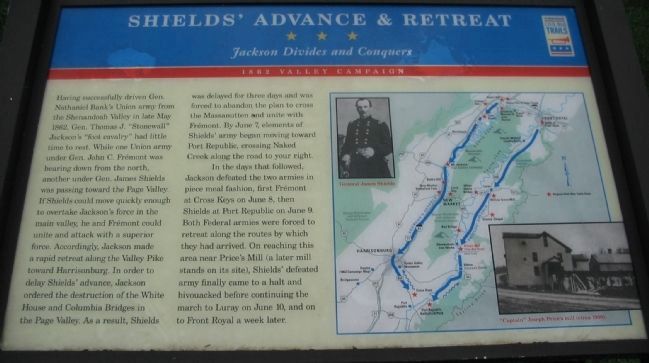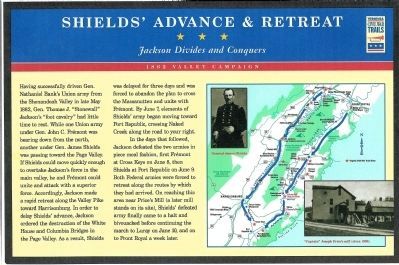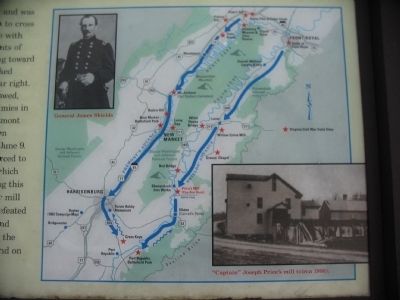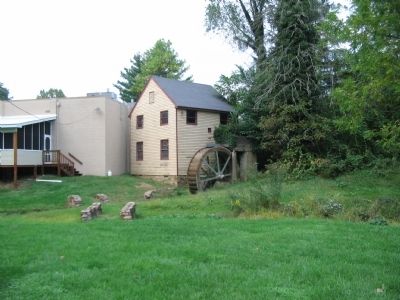Near Elkton in Page County, Virginia — The American South (Mid-Atlantic)
Shield's Advance & Retreat
Jackson Divides and Conquers
— 1862 Valley Campaign —
In the days that followed, Jackson defeated the two armies in piece meal fashion, first Frémont at Cross Keys on June 8, then Shields at Port Republic on June 9. Both Federal armies were forced to retreat along the routes by which they had arrived. On reaching this area near Price's Mill (a later mil stands on its site), Shields' defeated army finally came to a halt and bivouacked before continuing the march to Luray on June 10, and on the Front Royal a week later.
Erected by Virginia Civil War Trails.
Topics and series. This historical marker is listed in this topic list: War, US Civil. In addition, it is included in the Virginia Civil War Trails series list. A significant historical month for this entry is May 1862.
Location. Marker has been reported missing. It was located near 38° 27.929′ N, 78° 37.04′ W. Marker was near Elkton, Virginia, in Page County. Marker was at the intersection of Moose Bottom Road and U.S. 340, on the left when traveling east on Moose Bottom Road. Located just north of the Page and Rockingham County Lines, in a small park next to the Shenandoah Moose Lodge. Touch for map. Marker was at or near this postal address: 6386 East Side Hwy, Shenandoah VA 22849, United States of America. Touch for directions.
Other nearby markers. At least 8 other markers are within 2 miles of this location, measured as the crow flies. History of Verbena (here, next to this marker); Rockingham County / Page County (within shouting distance of this marker); Shenandoah Iron Works (approx. 1.3 miles away); WWI Cannon 1906 Model (approx. 1.4 miles away); The Stevens Cottage 1890 (approx. 1.4 miles away); Shenandoah Historic District (approx. 1.4 miles away); Veterans Memorial (approx. 1½ miles away); Shenandoah World War I & II Memorial (approx. 1.9 miles away).
More about this marker. To the right of the text is a map of the campaign, showing the Union advance along with important locations with related Civil War Trails markers. Inset with the map is a portrait of General James Shields and a photo of "Captain" Joseph Price's mill (circa 1900).
Regarding Shield's Advance & Retreat. This marker is one of several detailing Civil War activities in Page County, Virginia. Please see the Page County Civil War Markers link below.
Also see . . .
1. General James Shields. Prior to the war, Shields had served with distinction in the Mexican War. He is also remembered for having challenged Abraham Lincoln to a duel. The two later became friendly. Shields answered Lincoln's call for support at the beginning of the war, volunteering his services to the Union army. (Submitted on October 5, 2008, by Craig Swain of Leesburg, Virginia.)
2. Reports of Maj. Gen. James Shields. Concering his advance, Shields wrote:
my advance guard reached the Shenandoah at Honeyville, but found the White House Bridge and Columbia Bridge both burned, thus cutting off all hope of attacking his flank at New Market. I then pushed forward the advance as rapidly as possible, in hopes of finding the bridge at Conrad's Store still standing, but that bridge was also found burned. During the whole of this time, which occupied nearly three days, the rain poured down in torrents, so that the Shenandoah overflowed its banks, and the mountain streams became rivers. It became impossible to move forward; the wagons sank in the mud to the axles, and all communication was cut off for a time between the main body and the advance guard. In this condition the first question was to live, to obtain supplies, as none could reach us over such roads. (Submitted on October 5, 2008, by Craig Swain of Leesburg, Virginia.)
3. Page County Civil War Markers. (Submitted on February 25, 2009, by Craig Swain of Leesburg, Virginia.)
4. Avenue of Armies: Civil War Sites and Stories of Luray and Page County, Virginia. (Submitted on March 20, 2009, by Robert H. Moore, II of Winchester, Virginia.)
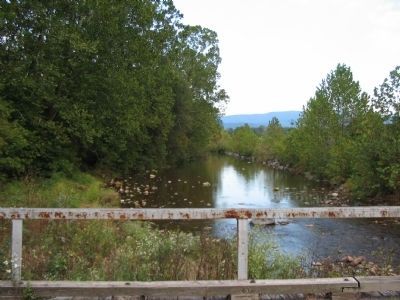
Photographed By Craig Swain, October 4, 2008
6. Naked Creek
Like many tributaries to the Shenandoah River, the creek presented an obstacle to military movements. The rocky bottom could be crossed by foot traffic, but wagons and cannon could not easily traverse. Columns, such as Shield's, required bridges or proper ford location in order to advance up the Valley.
Credits. This page was last revised on February 2, 2023. It was originally submitted on October 5, 2008, by Craig Swain of Leesburg, Virginia. This page has been viewed 2,367 times since then and 57 times this year. Last updated on January 29, 2023. Photos: 1. submitted on October 5, 2008, by Craig Swain of Leesburg, Virginia. 2. submitted on January 13, 2009, by Robert H. Moore, II of Winchester, Virginia. 3, 4, 5, 6. submitted on October 5, 2008, by Craig Swain of Leesburg, Virginia. • Bernard Fisher was the editor who published this page.
